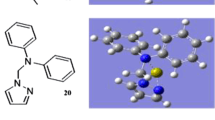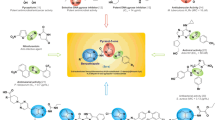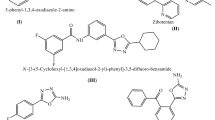Abstract
A series of 1,3-diaryl-2-propen-1-ones and their indole analogs were synthesized and evaluated for antibacterial activity. Structures of newly synthesized compounds were confirmed by physicochemical, spectral and elemental analysis. All the compounds were screened for their antibacterial activities against four different bacterial strains. The QSAR studies were performed using Vlife MDS 3.5 software. QSAR equation revealed that selected electronic, steric and lipophilic parameters have good correlation with antibacterial activity. Best equations were selected on basis of the correlation coefficient (r 2) and the predictable ability of the equations. The present findings suggest that the 1,3-diaryl-2-propen-1-ones framework is an attractive template for structure optimization to achieve higher potency, lower toxicity, and a wider spectrum of antibacterial activity.
Similar content being viewed by others
References
Al-Omran, F., & El-Khair, A. A. (2004). Synthesis of polyfunctionally substituted heteroaromatic compounds via benzotriazolyl chalcones with antimicrobial and antifungal activities. Journal of Heterocyclic Chemistry, 41, 327–333.
Audry, E., Dubost, J. P., Colleter, J. C., & Dallet, P. (1986). A new approach to structure-activity relations: the molecular lipophilicity potential. European Journal of Medicinal Chemistry, 21, 71–72.
Berber, I., Cokmus, C., & Atalan, E. (2003). Characterization of Staphylococcus species by SDS-PAGE of whole cell and extracellular proteins. Microbiology, 72, 54–57. DOI: 10.1023/A:1022221905449.
Deng, J., Sanchez, T., Al-Mawsawi, L. Q., Dayam, R., Yunes, R. A., Garofalo, A., Bolger, M. B., & Neamati, N. (2007). Discovery of structurally diverse HIV-1 integrase inhibitors based on a chalcone pharmacophore. Bioorganic & Medicinal Chemistry, 15, 4985–5002. DOI: 10.1016/j.bmc.2007.04.041.
Furniss, B. S., Hannaford, A. J., Smith, P. W. G., & Tatchell, A. R. (1989). Vogel’s textbook of practical organic chemistry, (5th ed., p. 1034.). London: Longman Scientific & Technical.
Gasull, E. I., Silber, J. J., Blanco, S. E., Tomas, F., & Ferretti, F. H. (2000). A theoretical and experimental study of the formation mechanism of 4-X-chalcones by the Claisen-Schmidt reaction. Journal of Molecular Structure: THEOCHEM, 503, 131–144. DOI: 10.1016/S0166-1280(99)00256-0.
Hall, L. H., & Kier, L. B. (1991). The molecular connectivity chi indexes and kappa shape indexes in structure-property modeling. In K. B. Lipkowitz & D. B. Boyd (Eds.), Reviews of computational chemistry (Vol. 2, Chap. 9, pp. 367–422). New York: VCH Publishers. DOI: 002/9780470125793.ch9.
Hasan, A., Khan, K. M., Sher, M., Maharvi, G. M., Nawaz, S. A., Choudhary, M. I., Atta-ur-Rahman, & Supuran, C. T. (2005). Synthesis and inhibitory potential towards acetylcholinesterase, butyrylcholinesterase and lipoxigenase of some variably substituted chalcones. Journal of Enzyme Inhibition and Medicinal Chemistry, 20, 41–47. DOI: 10.1080/14756360400015231.
Herencia, F., Ferrándiz, M. L., Ubeda, A., Dominguez, J. N., Charris, J. E., Lobo, G. M., & Alcaraz, M. J. (1998). Synthesis and anti-inflammatory activity of chalcone derivatives. Bioorganic & Medicinal Chemistry Letters, 8, 1169–1174. DOI: 10.1016/S0960-894X(98)00179-6.
Herencia, F., Lopez-Garcia, M. P., Ubeda, A., & Ferrándiz, M. L. (2002). Nitric oxide-scavenging properties of some chalcone derivatives. Nitric Oxide: Biology and Chemistry, 6, 242–246. DOI: 10.1006/niox.2001.0396.
Khan, M. S. Y., & Hasan, S. M. (2003). Synthesis, antiinflammatory and antibacterial activity of some new flavonoidal derivatives. Indian Journal of Chemistry, Section B, 42, 1970–1974.
Kier, L. B., & Hall, L. H. (1977). The nature of structure-activity relationships and their relation to molecular connectivity. European Journal of Medicinal Chemistry, 12, 307–312.
Lahtchev, K. L., Batovska, D. I., Parushev, St. P., Ubiyvovk, V. M., & Sibirny, A. A. (2008). Antifungal activity of chalcones: A mechanistic study using various yeast strains. European Journal of Medicinal Chemistry, 43, 2220–2228. DOI: 10.1016/j.ejmech.2007.12.027.
Lee, V. J., & Hecker, S. J. (1999). Antibiotic resistance versus small molecules, the chemical evolution. Medicinal Research Reviews, 19, 521–542. DOI: 10.1002/(SICI)1098-1128(199911)19:6<521::AID-MED4>3.0.CO;2-9.
Liu, M., Wilairat, P., Croft, S. L., Tan, A. L-C., & Go, ML. (2003). Structure-activity relationships of antileishmanial and antimalarial chalcones. Bioorganic & Medicinal Chemistry, 11, 2729–2738. DOI: 10.1016/S0968-0896(03)00233-5.
López, S. N., Castelli, M. V., Zacchino, S. A., Dominguez, J. N., Lobo, G., Charris-Charris, J., Cortes, J. C. G., Ribas, J. C., Devia, C., Rodriguez, A. M., & Enriz, R. D. (2001). In vitro antifungal evaluation and structure.activity relationships of a new series of chalcone derivatives and synthetic analogues, with inhibitory properties against polymers of the fungal cell wall. Bioorganic & Medicinal Chemistry, 9, 1999–2013. DOI: 10.1016/S0968-0896(01)00116-X.
Mishra, N., Arora, P., Kumar, B., Mishra, L. C., Bhattacharya, A., Awasthi S. K., & Bhasin, V. K. (2008). Synthesis of novel substituted 1,3-diaryl propenone derivatives and their antimalarial activity in vitro. European Journal of Medicinal Chemistry, 43, 1530–1535. DOI: 10.1016/j.ejmech.2007.09.014.
Mitscher, L. A., Pillai, S. P., Gentry, E. J., & Shankel, D. M. (1999). Multiple drug resistance. Medicinal Research Reviews, 19, 477–496. DOI: 10.1002/(SICI)1098-1128(199911)19:6<477::AID-MED2>3.0.CO;2-W.
Nowakowska, Z. (2007). A review of anti-infective and anti-inflammatory chalcones. European Journal of Medicinal Chemistry, 42, 125–137. DOI: 10.1016/j.ejmech.2006.09.019.
Ono, M., Hori, M., Haratake, M., Tomiyama, T., Mori, H., & Nakayama, M. (2007). Structure.activity relationship of chalcones and related derivatives as ligands for detecting of β-amyloid plaques in the brain. Bioorganic & Medicinal Chemistry, 15, 6388–6396. DOI: 10.1016/j.bmc.2007.06.055.
Pellerin, J. L., Bourdeau, P., Sebbag, H., & Person, J. M. (1998). Epidemiosurveillance of antimicrobial compound resistance of Staphylococcus intermedius clinical isolates from canine pyodermas. Comparative Immunology Microbiology & Infectious Diseases, 21, 115–133. DOI: 10.1016/S0147-9571(97)00026-X.
Sivakumar, P. M., Prabu Seenivasan, S., Kumar, V., & Doble, M. (2007). Synthesis, antimycobacterial activity evaluation, and QSAR studies of chalcone derivatives. Bioorganic & Medicinal Chemistry Letters, 17, 1695–1700. DOI: 10.1016/j.bmcl.2006.12.112.
Solankee, A., & Patel, J. (2004). Synthesis of chalcones, pyrazolines, aminopyrimidines and pyrimidinethiones as antibacterial agents. Indian Journal of Chemistry, Section B, 43, 1580–1584.
Sung, W. S., Jung, H. J., Park, K., Kim, H. S., Lee, I-S., & Lee, D. G. (2007). 2,5-dimethyl-4-hydroxy-3(2H)-furanone (DMHF); antimicrobial compound with cell cycle arrest in nosocomial pathogens. Life Sciences, 80, 586–591. DOI: 10.1016/j.lfs.2006.10.008.
Xu, Y. C., Leung, S. W. S., Yeung, D. K. Y., Hu, L. H., Chen, G. H., Che, C. M., & Man, R. Y. K. (2007). Structure. activity relationships of flavonoids for vascular relaxation in porcine coronary artery. Phytochemistry, 68, 1179–1188. DOI: 10.1016/j.phytochem.2007.02.013.
Author information
Authors and Affiliations
Corresponding author
Rights and permissions
About this article
Cite this article
Bhatia, N.M., Mahadik, K.R. & Bhatia, M.S. QSAR analysis of 1,3-diaryl-2-propen-1-ones and their indole analogs for designing potent antibacterial agents. Chem. Pap. 63, 456–463 (2009). https://doi.org/10.2478/s11696-009-0026-6
Received:
Revised:
Accepted:
Published:
Issue Date:
DOI: https://doi.org/10.2478/s11696-009-0026-6




